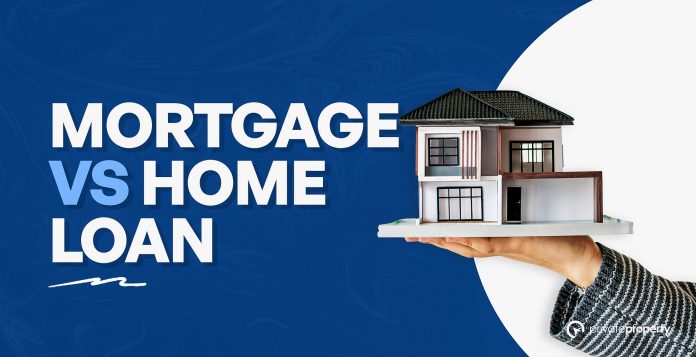Entering the realm of homeownership is an exciting journey filled with anticipation and big decisions. As you embark on this path, one of the primary considerations you’ll encounter is how to finance your new home. In the world of real estate financing, the terms “mortgage” and “home loan” are often used interchangeably, leading to confusion among prospective buyers. However, understanding the nuanced differences between these two financial instruments is crucial in making informed decisions that align with your financial goals and circumstances.
In this blog post, we’ll delve into the distinctions between mortgages and home loans, shedding light on their respective features, terms, and implications. Whether you’re a first-time homebuyer or a seasoned investor, having a clear grasp of these concepts will empower you to navigate the housing market with confidence and clarity. Let’s embark on this enlightening journey to demystify the realm of real estate financing and pave the way for your homeownership dreams to become a reality.
What is a Mortgage?
A mortgage is a type of loan specifically designed for purchasing real estate properties. It serves as a legal agreement between the borrower and the lender, typically a bank or a financial institution, where the borrower receives funds upfront to buy a property, and then repays the loan amount plus interest over a specified period, usually spanning several years.
Types of Mortgages:
Fixed-Rate Mortgage: With a fixed-rate mortgage, the interest rate remains constant throughout the loan term. This provides predictability and stability for borrowers, as their monthly payments remain consistent over time.
Adjustable-Rate Mortgage (ARM): Unlike fixed-rate mortgages, ARMs have interest rates that can fluctuate periodically based on market conditions. Initially, these loans often offer lower interest rates, but they carry the risk of rates increasing in the future, potentially leading to higher monthly payments.
Government-Insured Mortgages: These mortgages are backed by government agencies such as the Federal Housing Administration (FHA), the Department of Veterans Affairs (VA), or the United States Department of Agriculture (USDA). They often have more flexible qualification requirements and lower down payment options compared to conventional mortgages.
Jumbo Mortgages: Jumbo mortgages are loans that exceed the conforming loan limits set by government-sponsored entities like Fannie Mae and Freddie Mac. They are typically used for high-value properties and may have stricter qualification criteria.
READ MORE: Cash Vs Mortgage Financing: Which is the Better Option?
What is a Loan?
A loan is a financial arrangement where one party, the lender, provides funds to another party, the borrower, with the expectation that the borrower will repay the principal amount along with interest over an agreed-upon period. Loans can be used for various purposes, including purchasing homes, financing education, starting businesses, or covering unexpected expenses.
Home Loan Definition:
A home loan, also known as a mortgage loan or a housing loan, specifically refers to a type of loan used to finance the purchase of a residential property. It functions similarly to a mortgage, where the property serves as collateral for the loan. Home loans come in different types, each with its own terms, interest rates, and eligibility criteria.
Types of Loans:
Personal Loans: These are unsecured loans that borrowers can use for various personal expenses, including home renovations, debt consolidation, or covering unexpected costs. Since they are not tied to a specific asset, personal loans typically have higher interest rates compared to secured loans like mortgages.
Auto Loans: Auto loans are specifically used to finance the purchase of vehicles. Like mortgages, auto loans are secured by the purchased vehicle, and failure to repay the loan can result in repossession by the lender.
Student Loans: These loans are designed to help students cover the costs of higher education, including tuition, fees, and living expenses. Student loans often come with favorable terms, such as deferred repayment options or income-based repayment plans.
Business Loans: Business loans provide financing for entrepreneurs and business owners to start or expand their businesses. These loans can be used for various purposes, such as purchasing equipment, hiring employees, or investing in inventory.
Mortgage vs Home loan
The terms “mortgage” and “home loan” are often used interchangeably, leading to confusion among potential borrowers. However, there are subtle differences between the two that are important to understand when considering financing options for purchasing a home.
Mortgage:
A mortgage is a specific type of loan that is used to finance the purchase of a property, typically real estate. It involves a legal agreement between the borrower and the lender, where the lender provides funds upfront for the purchase, and the borrower agrees to repay the loan amount plus interest over a predetermined period, usually spanning several years.
Key features of mortgages include:
Secured by Property: Mortgages are typically secured loans, meaning that the property being purchased serves as collateral for the loan. If the borrower fails to make payments as agreed, the lender may have the right to seize the property through foreclosure proceedings.
Variety of Types: There are various types of mortgages available, including fixed-rate mortgages, adjustable-rate mortgages (ARMs), government-insured mortgages (such as FHA loans), and jumbo mortgages. Each type has its own terms, interest rates, and eligibility criteria.
Long-Term Commitment: Mortgages often involve long repayment periods, commonly ranging from 15 to 30 years. Borrowers make regular monthly payments over the life of the loan until the outstanding balance is paid off.
Home Loan:
A home loan, on the other hand, is a broader term that refers to any type of loan used specifically for purchasing a home. While a mortgage is a type of home loan, not all home loans are mortgages. Home loans can include other types of financing, such as personal loans or home equity lines of credit (HELOCs), that are used for home-related expenses but may not necessarily be secured by the property itself.
Key features of home loans include:
Versatility: Home loans encompass a variety of financing options beyond traditional mortgages. This can include personal loans, home equity loans, or HELOCs, which may offer flexibility in terms of usage and repayment.
Secured and Unsecured Options: While mortgages are typically secured by the property being purchased, other home loans, such as personal loans or HELOCs, may be secured or unsecured. Secured loans use the home as collateral, while unsecured loans do not require collateral but may have higher interest rates.
Shorter Terms: Some types of home loans, such as personal loans, may have shorter repayment terms compared to traditional mortgages. This can vary depending on the lender and the specific terms of the loan.
In summary, while both mortgages and home loans are used for financing the purchase of a home, a mortgage specifically refers to a loan that is secured by the property being purchased. Home loans, on the other hand, encompass a broader range of financing options that may include mortgages as well as other types of loans used for home-related expenses. Understanding the distinctions between these terms can help borrowers make informed decisions when navigating the process of financing a home purchase.
How Loans and Mortgages Are Taxed
Understanding how loans and mortgages are taxed is crucial for homeowners and borrowers as it can have significant financial implications. The tax treatment varies depending on factors such as the type of loan, the purpose of borrowing, and the specific tax laws of a country. Here’s a general overview of how loans and mortgages are taxed:
Tax Deductibility of Mortgage Interest:
In many countries, including the United States, mortgage interest payments are tax-deductible under certain conditions. This means that homeowners can deduct the interest they pay on their mortgage loan from their taxable income, reducing their overall tax liability.
However, there are limitations and eligibility criteria for mortgage interest deductions. For example, in the U.S., the mortgage interest deduction is subject to a cap on the amount of eligible mortgage debt and may only apply to primary and secondary residences.
Tax Treatment of Loan Interest:
The tax treatment of interest on other types of loans, such as personal loans or auto loans, varies. In general, interest paid on loans used for personal expenses, such as vacations or buying consumer goods, is not tax-deductible.
On the other hand, interest paid on loans used for investment purposes, such as margin loans for buying stocks, may be tax-deductible. Business loans used for qualified business expenses are also typically tax-deductible.
In conclusion, while the terms “mortgage” and “home loan” are often used interchangeably, it’s crucial to recognize the subtle yet significant differences between them. A mortgage specifically refers to a loan secured by the property being purchased, typically used for real estate transactions. On the other hand, a home loan is a broader term encompassing various types of financing options used for purchasing a home or other home-related expenses.
By educating themselves on the nuances of mortgages and home loans and seeking guidance from financial professionals as needed, borrowers can make informed decisions that align with their financial goals, preferences, and circumstances. Whether aiming to buy a first home, upgrade to a larger property, or tap into home equity for renovations or investments, a clear understanding of the differences and comparisons between mortgages and home loans empowers individuals to navigate the housing market with confidence and clarity.









